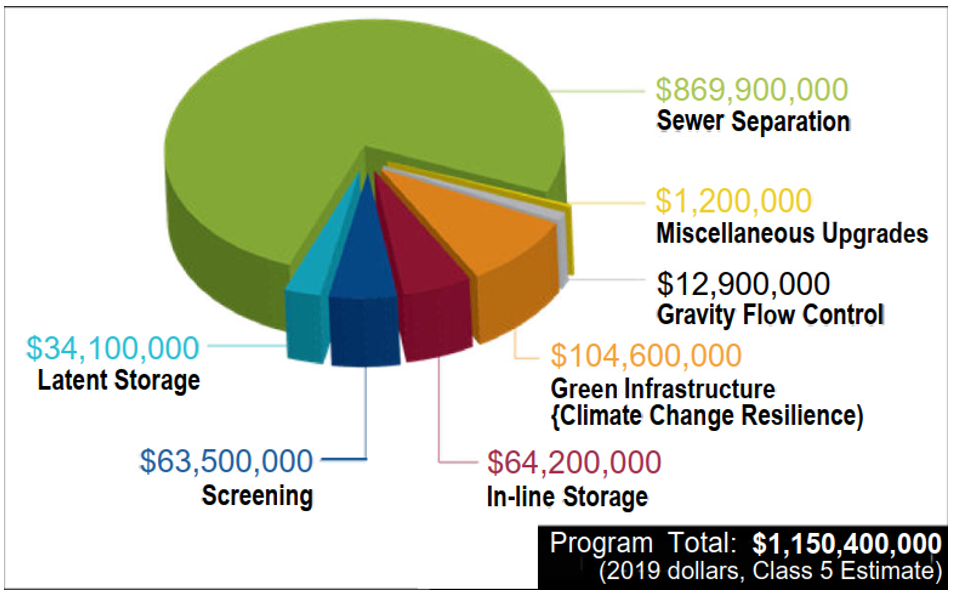CSO Master Plan
To see if there is any combined sewer overflow activity in your area, visit MyUtilityInfo.
- Introduction
- Timeline
- CSO Control Solutions
- Costs and Funding
- Implementation
- Benefits
- Documents
- Links
The City of Winnipeg is proceeding with a major infrastructure upgrade program, called the Combined Sewer Overflow (CSO) Master Plan, to manage the effects of combined sewer overflows (CSOs) on our waterways.
The CSO Master Plan includes proposed CSO control solutions, cost estimates, funding scenarios and provides a roadmap for achieving our goal of reducing CSOs in Winnipeg.
The operation of the combined sewer system in Winnipeg is governed by Environment Act Licence No. 3042 (EA No. 3042), issued by the Province of Manitoba (through Environment and Climate Change) in September of 2013.
Goals for Reducing CSOs
The CSO Master Plan outlines long-term goals for reducing the amount of CSOs entering our waterways and will be carried out in two phases.
Control Target 1
The CSO Master Plan will work to reduce the effects of CSOs on our waterways by increasing the amount of combined sewer flow that is treated at our sewage treatment plants before being released into the river. The plan is designed to take the 2013 baseline sewer system from collecting about 74 percent of the combined sewer flows and treating it, to collecting and treating 85 percent by 2045.
Control Target 2
The CSO Master Plan may work towards a higher level of CSO capture which is yet to be determined. A percent capture assessment to determine the next level of control is required by the Province on or before April, 2026.
An update on the CSO Master Plan is required to be submitted to Environment and Climate Change by April, 2030.
Note: all goals for CSO reduction are based on the Representative Year.
CSO Control Solutions
There are two types of control solutions that will be used in the CSO Master Plan to help reduce the effects of CSOs on our waterways; grey infrastructure and green infrastructure.
Grey infrastructure refers to the conventional, large scale infrastructure projects such as:
- Sewer separation
Physical separation involves installing an entirely new land drainage or wastewater sewer, separate from the combined sewer. The combined sewer is then converted to become exclusively a wastewater sewer or land drainage sewer, creating a separate sewer system. - In-line storage
In-line storage retains land drainage runoff (rain and snowmelt) in the combined sewer pipes during smaller wet weather events. Weir control gates are installed at CSO outfall points to prevent flows from reaching the river for a specific design event, storing flows in the sewer. Following the wet weather event, the stored flow, which contains both wastewater and land drainage runoff, is pumped to the sewage treatment plant as usual. Storage capacity is limited by the size of the existing sewer pipe. - Latent storage
The storage volume already available in relief sewers with separate outfalls is referred to as latent storage. This type of storage requires a new pump station to pump captured flows back to the combined sewer system as relief sewers are lower in level than combined sewers. Storage capacity is limited by the size of the existing sewer pipe and the river level, as high water levels in the river can hold relief sewers' outfall flap gates closed. - Off-line storage
Off-line storage utilizes tanks or other storage infrastructure to store flows during periods of heavy rainfall or snowmelt. Following the wet weather event, the stored flow, which contains both wastewater and land drainage runoff, is pumped to the sewage treatment plant. - Floatables management
The use of bar screening at discharge points (outfalls) to reduce the volume of debris reaching our waterways.
Green infrastructure (GI) refers to projects that use natural hydrologic processes to keep rainwater out of the sewer systems. The CSO Master Plan focuses on traditional and well-established grey infrastructure, but also includes provisions for green infrastructure. As CSO green infrastructure solutions are implemented, data on runoff control effectiveness, maintenance requirements, costs, challenges, and additional benefits will be collected. This information will be assessed to guide the program over time to ensure that sustainable and cost-effective solutions are being implemented. Where feasible, the following technologies may be utilized within the CSO Master Plan:
- Runoff water collection
Rain barrels capture and store roof runoff for future use, reducing flows that enter the combined sewer system. The collected water can be used for watering lawns and gardens. - Bioretention systems and bioswales
Bioretention areas, or rain gardens, are shallow surface depressions planted with specially selected native vegetation to capture and treat land drainage runoff. Wet weather flow will pool in the depression area and then infiltrate into the soil or evaporate.
Bioswales are swales that contain grass and other vegetation, which has an enhanced top soil layer and infiltration underlayer. They decrease the rate at which runoff flows, increasing surface contact time and the ability to soak into the soil.
While all species of vegetation have multiple benefits for runoff management, native or indigenous species of plants provide even greater benefits. They typically require less irrigation than non-native species and have a higher survival rate. In Winnipeg, native species have deeper roots systems which filter excessive nutrients from runoff. - Green roofs
Growing vegetation on flat or sloped roofs helps to soak up and store rain water and snowmelt. Simple vegetation with minimal access can be used, although the roof has to be designed for this extra load. There are also more intensive green roofs that are accessible to the public, creating park-like vegetation. Some examples are found at Manitoba Hydro Place and Millennium Library Park. - Permeable paving
Runoff is reduced by using pavement types that allow water to permeate and infiltrate into the ground below. Types of permeable paving include unit paving blocks and cobble stones. - Green streets
Green streets incorporate several different green infrastructure elements so that they can work together to reduce land drainage runoff. Other ways to increase the benefits of green streets are:- Maximizing tree canopies helps reduce runoff by catching rainfall, absorbing moisture and improving runoff quality.
- Using soil amendments, such as compost, when soils are disturbed during development. When healthy soils are removed or compacted, their effectiveness in retaining and filtering runoff is reduced.
- Ensuring existing habitats are protected and that the natural drainage systems are kept in place.
Costs and Funding
Conceptual level Class 5 capital cost estimates, which have an accuracy from -50 percent to +100 percent, were developed for the proposed control solutions selected for each sewer district. The figure below shows a breakdown of the proposed work to achieve the 85 percent capture in a representative year.

Applying the Class 5 estimating range, the total cost of the CSO Master Plan implementation could range from $575 million to $2.3 billion in 2019 dollars. Changes in Capital Cost Estimates.
There have been changes in the capital cost estimates since the CSO Master Plan Preliminary Proposal was submitted on December 17, 2015. Reasons for the differences in capital costs are as follows:
Inflation of the Preliminary Proposal
The capital cost estimates in the Preliminary Proposal were in 2014 dollar values. Inflation at three percent between the years of 2014-2019 equate to a net 16 percent increase (greater than $200 million) between the Preliminary Proposal and Master Plan.
Change in the classification range of accuracy for cost estimating
For the Preliminary Proposal, a plus 50 percent of capital cost was used to represent the budget estimating amount. In 2015, the City moved to the AACE classification system and the top end of the accuracy range was increased to plus 100 percent of capital cost (a $700 million increase).
Preliminary Proposal to Master Plan Program Changes
- Added ten percent to account for including Green Infrastructure solutions (greater than $100 million) for licence compliance. Green Infrastructure will also provide climate change resiliency
- Increased level of solution detail
- An increase in the amount of sewer separation projects selected for control options, which have a higher capital cost, but lower operating costs
| Item | Preliminary Proposal 2014-Capital Costs |
Preliminary Proposal 2019-Capital Costs |
Master Plan 2019- Capital Costs (March MP)** |
|---|---|---|---|
| Base Construction with Markup | $829,500,000 | $962,000,000 | $1,150,400,000 ** |
| Base Cost + 50 percent Estimating Allowance | $1,245,000,000 * | $1,444,200,000 | $1,725,600,000 |
| Base Cost + 100 percent Estimating Allowance | $1,659,000,000 | $1,924,000,000 | $2,300,800,000 ** |
* Cost as shown in 2015 Preliminary Proposal with a +50 percent estimating allowance
** Cost as shown in the Master Plan includes a 10% allowance for green infrastructure projects
Funding Scenarios
Council has directed the City to assesses the feasibility of meeting the 2045 provincial deadline for 85% capture in a representative year with City only funding.
The current average annual CSO budget in order to fund the CSO Master Plan work is $30 Million. In 2021, City Council recommended a $60 million increase to the CSO Master Plan budget over 4 years from 2024 to 2027 ($15 million a year), which was adopted into the budget.
| Program Scenario | Description | Funding by | Annual Budget | Completion Timeline |
|---|---|---|---|---|
| Scenario 1 | 3 Levels of Funding 3 x $30 Million |
City + Two Additional | $90 Million | 2047 (27 years) |
| Scenario 2 | 2 Levels of Funding 2 x $30 Million |
City + One Additional | $60 Million | 2059 (39 years) |
| Scenario 3 | 1 Level of Funding 1 x $30 Million |
City | $30 Million | 2095 (75 years ) |
Costs as shown in the 2019 CSO Master Plan program scenarios
Annual cost escalation at three percent for construction is a significant risk to the CSO Master Plan. If committed funding is less than the forecasted it could result in four times the capital costs and take three times longer to implement. To put cost escalation into context, the work to complete aspects of the Aqueduct in 1919 cost approximately $17 million in 1919 dollars. That same work escalated to 2018 dollars would cost over $1.15 Billion dollars (99 years later).
Implementation
Following submission of the CSO Master Plan in August 2019, Manitoba Conservation and Climate approved the CSO Master Plan in November 2019. The City will continue with the committed sewer separation projects and annual CSO results reporting as required by EA No. 3042 and meet the new requirements in the implementation phase.
The Water and Waste Department has transitioned from program planning to program management for the implementation phase.
Committed Projects
There are multiple projects within the CSO Master Plan, many of which the City has already started implementing:
Sewer Separation Projects
The City has been actively completing large sewer separation projects in the following sewer districts since 2013:
- Cockburn and Calrossie
- Ferry Road and Riverbend
- Jefferson East
- Armstrong
- Mission and Roland
- Cockburn East
Ongoing Water Quality Monitoring
As part of the CSO Master Plan for regulatory compliance, 2023 and 2024 water quality monitoring was completed. The City completed water sampling and testing at multiple locations on our rivers and streams. We also sampled and tested water quality at two combined sewer overflow locations. Similar testing was completed in 2014/2015.
These tests will tell us about levels of nutrients and bacteria in the water, and other characteristics such as temperature. The tests help to quantify the impact of sewer discharge on our waterbodies. These findings also help the City to make decisions about future sewer improvements. This program is in addition to the regular river and stream water quality monitoring done by the City.
Secure Funding
The program implementation included a start-up period of four years following submission of the CSO Master Plan. This time is to allow for a multi-year tri-government funding agreement to be put in place.
On October 12, 2023, City Council directed Water and Waste to assess the feasibility of City only funding which could change the budget and associated time it takes to deliver the program. The October 12, 2023 council decision can be found here.
Annual Progress Reporting
Approval of the CSO Master Plan triggered Clause 13 of EA No. 3042 requiring annual progress reporting to begin. This includes a summary of planned and completed projects and an estimate of the system performance for the 1992 Representative Year.
The reports can be found here.
2030 CSO Master Plan Update
The CSO Master Plan update, scheduled for 2030, may substantially increase the program requirements. Close collaboration with Manitoba Conservation and Climate Change on regulatory issues will be required throughout the evaluation period to determine the next target level of CSO control.
Benefits
The main benefits of CSO Master Plan are:
- Fewer sewer overflows during wet weather events
- Lower risk for basement flooding in Winnipeg homes
- Green Infrastructure will beautify our city with more trees and lush landscaping
- Our sewer system will be able to operate more efficiently
Sewer Separation
Sewer separation projects have been selected for combined sewer districts where basement flooding relief projects are required, thereby providing shared costs and joint benefits. Sewer separation projects also:
- Lower long-term maintenance and treatment costs for our sewage treatment plants, as less rainfall will be directed to the plants during wet weather events
- Reduce the occurrences of sewer backup and basement flooding
- Improves water quality, as there will be fewer instances of bacteria spikes and floatables entering the river
- Creates additional storage capacity for increased real-time control benefit
- Reduces flood pumping and the requirement to screen
In-line and Latent Storage
In-line and latent storage are inexpensive and offset the need for much more expensive CSO control options by using infrastructure that is already in place to provide additional temporary storage for rainfall during wet weather events.
Off-line Storage
Off-line storage does not disrupt the current sewer system during construction, meaning long diversion of existing flows is not required.
Green Infrastructure (climate change resilience)
Green infrastructure (GI) projects not only beautify our city, but also:
- Reduce the volume of rainfall runoff that might otherwise enter into the combined sewer system
- Improve the water quality of nearby waterways, as they can reduce the amount of pollutant from runoff
- Those that include a tree canopy provide cooling effects and help improve air quality
GI solutions are proposed to provide resilience to the potential impacts of climate change on the CSO Master Plan. An additional 10% has been added to the CSO Master Plan budget to account for the increased cost for GI solutions to capture additional runoff and improve water quality while also providing multiple additional benefits.
Real-time Control
The benefits of installing flow monitors and flow control structures in the sewer system include:
- Optimizing the capacity during wet weather events
- Reducing the volume of CSO discharge to the rivers
- Protecting against basement flooding
Alternative Floatables Management
Alternative floatables management projects are beneficial to our waterways as they will:
- Reduce the volume of floatables reaching our waterways by using methods such as source control, catch basin cleaning and street sweeping
- May result in reduced sewer cleaning requirements
- Improve road drainage efficiency
Documents
- 2024 River Stream and CSO Discharge Water Quality Monitoring Report
- 2024 CSO Annual Report
- 2023 CSO Annual Report
- 2022 CSO Annual Report
- 2021 CSO Annual Report
- 2020 CSO Annual Report
- 2019 CSO Annual Report
- 2019 CSO Master Plan Approval Letter
- 2019 CSO Master Plan
- Alexander District Plan
- Armstrong District Plan
- Ash District Plan
- Assiniboine District Plan
- Aubrey District Plan
- Baltimore District Plan
- Bannatyne District Plan
- Clifton District Plan
- Cockburn and Calrossie Districts Plan
- Colony District Plan
- Cornish District Plan
- Despins District Plan
- Doncaster District Plan
- Douglas Park District Plan
- Dumoulin District Plan
- Ferry Road District Plan
- Hart District Plan
- Hawthorne District Plan
- Jefferson East District Plan
- Jefferson West District Plan
- Jessie District Plan
- La Verendrye District Plan
- Linden District Plan
- Mager District Plan
- Marion District Plan
- Metcalfe District Plan
- Mission District Plan
- Moorgate District Plan
- Munroe District Plan
- Munroe Annex District Plan
- Newton District Plan
- Parkside District Plan
- Polson District Plan
- River District Plan
- Riverbend District Plan
- Roland District Plan
- Selkirk District Plan
- St. Johns District Plan
- Strathmillan District Plan
- Syndicate District Plan
- Tuxedo District Plan
- Tylehurst District Plan
- Woodhaven District Plan
The District Engineering Plans are part of 2019 CSO Master Plan, not standalone documents.
- 2017 CSO Master Plan Preliminary Proposal Approval Letter
- 2015 CSO Master Plan Preliminary Proposal
- 2013 CSO Environment Act Licence No. 3042







